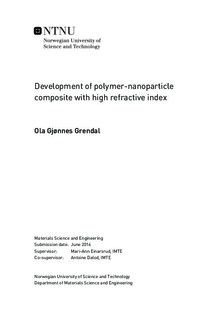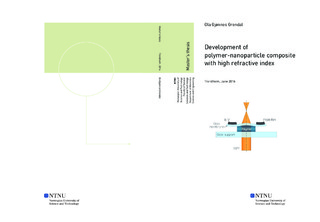| dc.description.abstract | A newly developed lens technology utilizes a soft high refractive index polymer to change focus. By further increasing the refractive index of the polymer, without lowering the transmittance of visible light, the overall lens properties will be improved. Dispersion of TiO2 nanoparticles into the polymer was chosen for this because of TiO2 high refractive index.
In this work, a polymer-nanoparticle composite with high refractive index is developed by dispersing TiO2 nanoparticles into the polymer. The polymer-nanoparticle composite was characterized with respect to refractive index and transmittance of visible light. A major part of the work evolved around achieving a homogenous dispersion of non-agglomerated TiO2 nanoparticles. Different approaches was used, including in situ functionalization and post synthesis methods like ultrasonification and electrostatic stabilization of the TiO2 nanoparticles. Non of the approaches were successful in achieving non-agglomerated particles, making the polymer-nanoparticle composite milky white, and the transmittance of visible light very low. A small increase in refractive index was observed. This approach for making a polymer-nanoparticle composite with high refractive index and high transmittance of visible light is promising, but work on achieving non-agglomerated particles must be done.
The TiO2 nanoparticles used were made by a hydrothermal synthesis route with titanium (IV) isopropoxied (TIP) as precursor, and in situ functionalized with 3-aminopropyl trietoxhysilane (APTES). The effect of different synthesis parameters (shorter reaction time, lower reaction temperature and acidic versus basic reaction conditions) on the size and morphology of the synthesized particles were investigated. A drastic change in morphology was observed between acidic and basic reaction conditions. Under basic reaction conditions, big elongated particles (up to 200 nm long) formed, while for acidic reaction conditions small spherical particles (around 10 nm) were observed. This was believed to arise from a combination of oriented attachment and specific adsorption of APTES to different crystallographic faces. | |

